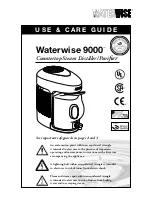
12
ICE CFA1012A I&O Manual 01/2021 New
Chapter 2 Installation
WARNING
Failure to observe and follow Warnings and Cautions and these Instructions could result
in death, bodily injury or property damage. Read this manual and follow its instructions
and adhere to all Cautions and Warnings in the manual and on the ICE unit.
2.1 Equipment Inspection
Concealed Damage
Inspect all cartons and packages upon receipt for damage in transit Remove cartons and check for
concealed damage.
Important: keep the unit upright at all times.
Remove access panels and examine
component parts. Inspect refrigerant circuit for fractures or breaks. The presence of refrigerant oil
usually indicates a rupture. If damage is apparent, immediately file a claim with the freight carrier.
Units that have been turned on their sides or tops may have concealed damage to compressor motor
mounts or to the oil system. If the unit is not upright, immediately file a claim for concealed damages
and follow these steps:
1. Set unit upright and allow to stand for 24 hours with primary power turned on.
2. Attempt to start the compressor after 24 hours.
3. If the compressor will not start, makes excessive noise, or will not pump, return the unit to the
freight carrier.
2.2 Installation Requirements
General
1. Inspect unit for completeness. Check for missing parts (e.g. hardware). Refer to the installation
kit information in section 2.3.
2. Remove access panels and check for loose wires. Tighten screw connections.
3. Complete and mail the warranty registration card.
You must consider all of the following when choosing the installation site:
1. Evaporator Condensate Drainage
. Condensate produced during operation must be discharged from
the evaporator pan through the primary and/or secondary drain hoses. Make sure the condensate
lines are free of any restrictions.
Condenser Pan Drainage.
Water from rain will accumulate in the condenser drain pan and should
discharge from the condenser pan through the drain line. Make sure the drain hole and line are not
restricted due to trash or crimping.
2. Placement.
A. Place the unit in a shaded area, if possible.
B. Install it above ground for protection against flooding.
C. Make sure the airflow from the condenser section and vent hood are not impeded by shrubbery
or other obstructions.
D. Make sure the unit is installed level.
3. Clearances:
The units are designed to operate when either the left or right side (not both) on the condenser
section are blocked. The open side and the top should have a minimum clearance of 24". The rear
of the unit should be 60" from any obstruction to air flow.












































